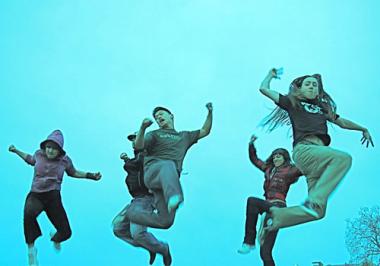Most of the performers gracing the stage at Northampton's Academy of Music next week in West Side Story are high school- and college-age, with a few notable exceptions like radio personalities Bill Dwight and Chris Collins.
"I could have cast this musical early on if I'd wanted to do it with a top-notch theater group," said Pioneer Arts Center director David Fried Oppenheim. "But I wanted to find people with less experience and training: non-traditional theater people. … This show is not about polish, it's supposed to be rough, feel rough."
The show is a hip-hop adaptation of West Side Story. Conceived by choreographer Jerome Robbins, West Side Story is a take on Shakespeare's Romeo and Juliet and a comment on racism. In it, two warring ethnic gangs, the Sharks (recently immigrated Puerto Ricans) and the Jets (mostly white native New Yorkers), fight for control of the same turf on the Upper West Side.
Inspired by the national debates on immigration and race during the 2008 presidential election, Oppenheim decided to stage this adaptation to reflect how American society has changed since the '50s, but show that the themes of West Side Story are still relevant.
"After 50 years, West Side Story has become a period piece," said Oppenheim in a recent interview with the Advocate. "I kept seeing and hearing on the TV and radio these people talking about the Civil Rights movement that happened in the '50s. They were talking about it as if it was this thing that was fought and won. That's just not true—it's an ongoing fight."
Pairing with Smith graduate student and dancer/choreographer Maura Nguyen Donohue, Oppenheim drastically changed the staging of the show and incorporated several styles of hip-hop dance.
For months, Oppenheim and Donahue pored over the script. They were not allowed to change lines or the Leonard Bernstein musical score at all due to copyrights, but they were allowed to alter the staging and choreography any way they deemed fit.
Because the original stage directions were written by stage managers and directors—instead of the writers—Oppenheim believes that some of the characters are fairly two-dimensional.
"I'm trying to use staging to actually show the depths of the characters," said Oppenheim.
In a rumble during which rival gang leaders Riff and Renaldo are killed, the original stage directions call for Tony, Riff's best friend, to hold his dying body, while Renaldo is left to die alone. Oppenheim's adaptation has Chino, Renaldo's best friend, hold Renaldo's body as well.
"I did this so that it parallels on either side of the friendship," said Oppenheim. "A lot of criticism I've heard about the original West Side Story is that it focuses too much on Tony and his inner dialogue."
In order to find an eclectic group of unseasoned performers, Oppenheim and his crew put up signs and spread the word that P.A.C.E. was looking for people with various backgrounds in dance like break dancers, crumpers or capoeira dancers.
The resulting cast includes immigrants from Puerto Rico, Bangladesh, Nigeria, Croatia, the Dominican Republic and Haiti, as well as many Americans.
This production also features an orchestra boasting some 30 members, most of whom are based in the Valley. The size of the orchestra is one of the reasons Oppenheim is presenting the musical at the Academy of Music in Northampton instead of at his venue in Easthampton.
"We're not even sure all of the orchestra is going to fit in the pit at the Academy, never mind at P.A.C.E.," said Oppenheim. "The cost of the show is close to $60,000. If we ran it at P.A.C.E., we'd have to run it for several weeks and charge $100 per ticket just to be able to afford the royalties."
Oppenheim isn't just putting on this show to make money—although he's quick to point out that if the show does put P.A.C.E. in the black, the organization will be in much better shape to mount next year's show. Oppenheim's main mission is to broaden the base of theatergoers and expose a wider variety of people to theater.
"A lot of theater groups in the Valley focus on just putting on a good show," said Oppenheim. "Our focus as an organization is to educate people, bring new people to the theater and, ultimately, say something with a piece we present."
In keeping with that mission, P.A.C.E. is working with local businesses and organizations who buy blocks of tickets to donate to underprivileged youth, including members of a Connecticut reform school who are writing a rap version of West Side Story.
"This isn't art just for art's sake," said Oppenheim.
P.A.C.E. presents West Side Story on April 23-27 at the Academy of Music, located at 274 Main St., Northampton, (800) 595-4TIX, www.pacetheater.com. Tickets are $20-50.



